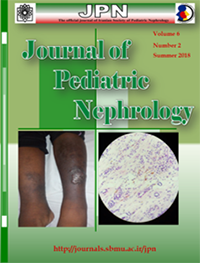Severe Intracranial Hemorrhage in a Newborn with Autosomal Recessive Polycystic Kidney Disease
Journal of Pediatric Nephrology,
Vol. 6 No. 2 (2018),
4 August 2018
,
Page 1-3
https://doi.org/10.22037/jpn.v6i2.22221
Abstract
Autosomal recessive polycystic kidney disease (ARPKD)is an autosomal recessive inherited developmental kidney disorder characterized by bilateral cystic dilatation of renal collecting ducts. The liver is always affected, with various degrees of biliary dysgenesis and periportal fibrosis. Intracranial aneurysms (ICA) can be associated with autosomal dominant polycystic kidney disease (ADPKD) in 5-10% of the cases, but extremely rarely with ARPKD.
We described a full-term male infant with ARPKD born with an extremely distended abdomen and anuria. Bilateral nephrectomy and open liver biopsy were performed during the first month of hospitalization, as well as the insertion of a peritoneal dialysis catheter. On the 59th day of life, the baby`s condition abruptly deteriorated and he showed a decreased level of consciousness, coma (GCS=3), and severe anemia. Head ultrasound and head CT scan revealed large hemorrhage in the left cerebral hemisphere. Hemostasis parameters, as well as clinical and laboratory signs of infection, were in referral ranges at the time of neurological deterioration. MRI showed large hemorrhages in the left ventricle and left cerebral hemisphere but a preexisting intracranial aneurism (ICA) in the site of hemorrhage could not be diagnosed for sure. The baby died on the 66th day of life.
Keywords: Polycystic Kidney, Autosomal Recessive; Intracranial Hemorrhages; Intracranial aneurysm; Newborn.
- Polycystic Kidney
- Autosomal Recessive
- Intracranial Hemorrhages
- Intracranial aneurysm
How to Cite
References
Fonck C, Chauveau D, Gagnadoux MF, Pirson Y, Grünfeld JP. Autosomal recessive polycystic kidney disease in adulthood. Nephrol Dial Transplant 2001;16:1648-1652.
Onuchic LF, Furu L, Nagasawa Y et al. PKHD1, the polycystic kidney and hepatic disease 1 gene, encodes a novel large protein containing multiple immunoglobulin-like plexin-transcription-factor domains and parallel beta-helix 1 repeats. Am J Hum Genet 2002;70:1305-1317.
Munding M, Al-Uzri A, Gralnek D,Riden D. Prenatally diagnosed autosomal recessive polycystic kidney disease: initial postnatal management. Urology 1999;54:1097xi-1097xii.
Thomas J, Manjunath AP, Rai L, RanjiniKudva. Autosomal recessive polycystic kidney disease diagnosed in fetus. Indian J Urol 2007;23(3):328-329.
Herman TE, Siegel MJ. Neonatal autosomal recessive polycystic kidney disease. J perinatology 2008;28:584-585.
Neumann HPH, Krumme B, van Velthoven V, Orszagh M, Zerres K. Multiple intracranial aneurysmys in patient with autosomal recessive polycystic kidney disease. Nephrol Dial Transplant 1999;14:936-939.
Lilova MI, Petkov DL. Intracranial aneurysms in a child with autosomal recessive polycystic kidney disease. Pediatr Nephrol 2001;16:1030-1032.
Chalhoub V, Abi-Rafeh L, Hachem K, AyoubE, YazbeckP. Intracranial aneurysm and recessive polycystic kidney disease: the third reported case. JAMA Neurol 2013;70(1):114-116.
Gabow PA. Autosomal polycystic kidney disease. In: Gardner KD Jr, Bernstein J (eds) The cystic kidney. Kluwer, London, 1990;pp295-326.
Pirson Y, Chauveau D, Torres V. Management of cerebral aneurysms in autosomal dominant polycystic kidney disease. J Am Soc Nephrol 2002;13(1):269-276.
- Abstract Viewed: 261 times
- PDF Downloaded: 233 times

